Library readies for ‘disappearance’ of sun
By Burton Cole
FALMOUTH — Hannah Pearson wore a black T-shirt emblazoned with the NASA logo, a time lapse series of images depicting a full solar eclipse, and the date, April 8, 2024.
“I’ve been looking forward to this eclipse for eight years,” the Pendleton County Public Library programming assistant said.
Her dad, a physics teacher, passed the love of science down to her. Her parents traveled to view the last total eclipse of the sun to be seen from the United States, which passed over southwest Kentucky and northeast Tennessee on Aug. 21, 2017. “The closest it came to us was Murfreesboro, Tenn.,” Pearson said.
She was unable to go then but was already planning not to miss 2024.
Pearson is positively giddy about sharing her excitement with schools, community groups and during an Eclipse Tips and Tricks program scheduled for 1 p.m. Friday at Kincaid Lake State Park Conference Center, 565 Kincaid Park Road.
Specialized viewing equipment will be demonstrated, youngsters can craft eclipse artwork, solar-related games will be played and a science station will let attendees “learn more than you want to know,” Pearson said.
Also, those registering for the free event will be encouraged to bring a black shirt to make their own eclipse gear with glow-in-the-dark paint.
“We provide the tools and the paint,” Pearson said. “The glow-in-the-dark paint pops out of black nicely.”
Library still also will be sharing details on Eclipse Soundscapes, a community science project in coordination with NASA.
“Everyday citizens — even school kids — gather data or observations of all sorts of subjects — clouds, the eclipse, animal behavior during the eclipse, etc. — and submit it to NASA for analysis,” according to the library.
“The library applied to be a data collector, which means we will receive an Audiomoth ambient sound data collection device, which we will place outdoors in Pendleton County two days before the eclipse to collect sound data for about a week surrounding the eclipse.
“Our library will contribute data to NASA.”
Call the Pendleton County Public Library at 859-654-8535 to register for the Saturday program so that enough family eclipse activity kits and activity station materials can be assembled.
WHAT IS AN ECLIPSE?
“It’s just a shadow, basically,” Pearson said.
A solar eclipse occurs when the moon passes between the earth and the sun, causing an abrupt daytime darkness for two to four minutes, she said.
The total solar eclipse will show across a 115-mile-wide band across 13 states, which runs a bit north of Pendleton County. This area will experience a partial eclipse, she said.
“Here, the maximum point of the eclipse will be 98.4 percent, so a sliver of light will peek around the shadow,” Pearson said.
“Instead of darkness, it will look like an overcast day.”
But, Pearson cautions, it still is not safe to stare directly into the sun, even if it’s just a sliver.
“The way I describe it is a photon punch becomes a photon poke,” she said.
Staring directly into any light long enough can burn one’s retinas to cause permanent damage to the eyes.
Typically, if a person glances directly at the sun, he reflexively flinches from the “punch,” and no damage is done, she said. The less-intensive “poke” may allow a person to stare longer but the danger remains the same.
That is why people who wish to see the eclipse need the protection of specially filtered glasses or other safety measures, she said.
EFFECTS OF AN ECLIPSE
An eclipse won’t change tides, affect gravitational pulls or act as a harbinger of travesty, but there are some interesting things that will occur, Pearson said.
With a solar eclipse, darkness falls quickly compared to a typical sunset when nightfall occurs gradually.
The eyes have time to adjust with the gradual change.
“The rods and cones in our eyes don’t have time to adjust with an eclipse, so we see colors differently,” she said.
“Shadows look silvery, reds look like blacks or grays, and greens and blues appear neon for a few seconds.”
Also, the darkness can confuse nature, which is where the Soundscape project comes in: “Do night birds come out? Do bats come out? Do crickets come out?”
ECLIPSE TOOLS
Among the eclipse viewing tools the library will demonstrate is a Sunspotter solar telescope.
The wooden base unfolds into a triangular pattern. Through a series of mirrors, the refractor projects a crisp image of the sun onto a piece of paper.
“It clarifies the image of the sun to the point that you can see sunspots,” Pearson said.
Sunspots are magnetic “cold holes” in the sun’s plasma, she said.
The Sunspotter was secured through a grant from the Rural Library Network, a subsidiary of Partners for Rural Impact, she said.
The library also has obtained Sunoculars through a grant from the Northern Kentucky Community Action Commission. Sunoculars look like regular binoculars with black lenses.
The lenses actually are densely filtered to allow a person to view the sun directly.
With 32X magnification and the filtration systems, “you can look at the sun directly and see the spots if you can hold your hands steady enough,” she said. “So far, I haven’t been able to hold steady.”
The Sunspotter and Sunoculars will be part of library equipment and can be used throughout the year for solar observations, not just the eclipse.
Safe viewing glasses will be passed out during the Eclipse Tips and Tricks event Saturday. For further view safety, kids will be able to make paper plate masks.
Their solar glasses will fit inside the masks, which they can decorate with strips of oranges, reds and yellow sun beams.
Other fun will include a giant version of the space card game How Big? How Far? How Hot?, provided by Science/Technology Activities and Resources (STAR) Network for Libraries and the Space Science Institute .
Mostly, Pearson hopes this Saturday to pass along with the sense of excitement she shared with her late father and to get Pendleton County residents ready for one of the rarest events of nature, a total (or near total, locally) eclipse of the sun.
“We designed all of the programs to be in preparation of the eclipse,” Pearson said.
“We want them to have the glasses ahead of time, to know the safety ahead of time.”
And to have fun with science.



